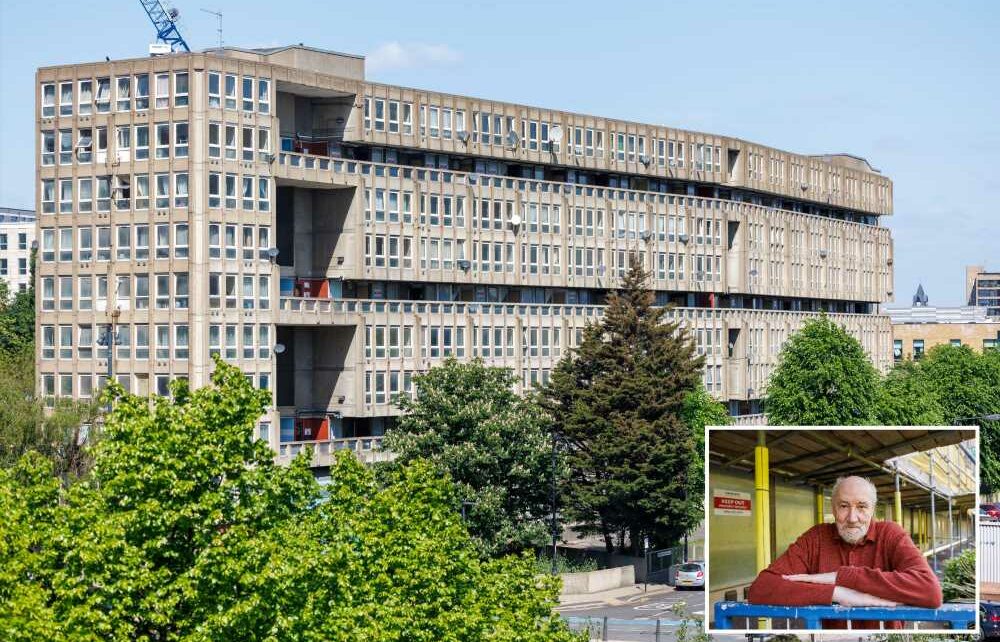THE LAST few residents living on a brutalist housing estate so ugly half of it has been torn down say they used to love their homes.
Robin Hood Gardens estate in Poplar, east London, opened in 1972 as social housing with a unique "streets in the sky" walkways connecting neighbours.






Its western block was demolished in 2018 after years of decay and anti-social behaviour left it uninhabitable.
But those still living in its eastern block, also earmarked for demolition, said their homes were lovely when they first moved in.
Pensioner Robert Smith, 75, moved into his flat in the remaining block 30 years ago.
The former tailor told The Sun: "It was so nice here. We had lovely neighbours who we knew well and always spoke to.
"There was a sense of community. Now everybody's gone. It's terrible what they've done with the place."
He said most of his neighbours were moved out years ago, and replaced with "new people".
"Then they were doing drugs and god knows what. While it was all families before. It's been heart-breaking to watch it become what it is now."
'THEY WRECKED IT'
Robert's well-maintained ground floor flat is freshly painted and has flowers in a vase in the window.
Most read in The Sun

This Morning war erupts as hosts threaten to quit after Phil's affair revelation

Rob Edwards breaks down in tears speaking about Lockyer injury after promotion

Coronation Street star splits from long-term boyfriend

Holly Willoughby slams Phillip Schofield's 'very hurtful' lies over affair
But it's surrounded by scaffolding and the two flats either side are boarded up.
He added: "They've wrecked it. Since the scaffolding went up we can't get any daylight in.
"It's so sad in a way. There are regular water leaks here, the building is falling apart. It's been terrible recently.
"A lot of people have had break ins."
Robert spent the last three decades watching as the surrounding area transformed into what it is today – he saw Canary Wharf and the docklands brought back to life.
He said: "I saw Canary Wharf being built. Kids used to play outside on the mound here. There was a park. It really changed."
The estate, originally made up of 213 flats surrounding a central garden area, was made up of two elongated blocks – one of ten and one of seven storeys.
Its architects, husband and wife team Alison and Peter Smithson, created "streets in the sky" – wide corridors outside the flats where neighbours could congregate and socialise.
Another resident, Shukri Ali, 72, has lived in her flat for 39 years.
She's waiting for a flat across the green, in one of the towers which have replaced the demolished block.
She said: "Once those flats are finished I'll move into one. It's been difficult living here. There are so many problems with the building. It was okay years ago but now we need to leave."
SQUATTERS
A site caretaker confirmed there are still ten occupied flats in the block.
He added: "There are ten official residents and then a lot more squatters.
"We're constantly called out to fix broken doors. They just kick them down. They're back here every night without fail. They're harmless enough though."
The homes, which border the noisy Blackwall Tunnel approach, were designed to be as comfortable as possible.
They were a mixture of single storey flats and two-storey maisonettes.
Bedrooms were built on the inside of the blocks to keep away from the noise from the road.
And the windows were large to allow in as much light as possible.
Some 70 per cent of residents had a car parking space below ground level.
Simon Smithson, the architects' son, said: "Shouldn't the East End have an architecture to match that of Bath, Brighton or Harrogate."
Former resident Darren Pauling said in 2010: "I have lived on the Robin Hood Gardens estate for over a decade and in Poplar all of my life. I love where I live."
Motiur Rahman, whose family lived on the estate for 23 years, told art exhibition Brutalism as Found the open-air walkways reminded him of Bangladesh.
He added: "People did unbelievable things on them, like riding bikes – I don’t mean one bike but four bikes going past each other. They played Carrom Board, it was so wide.
"In Eid, the doors would be open in every house and you would have all these people, swathes of people going up and down the corridors in their glitzy outfits, going to people’s houses, eating samosas. It gave you the opportunity to live an outdoor life.”
William and Laetitia Fakamus said "here we all know each other" because of the shared space outside their front doors.
SOVIET MONOLITH
Adrienne Sargeant lived in two maisonettes between 1974 and 2011.
She said she got home from school one day to find fake snow across the green, as a 1980s Levi's commercial was filmed.
The producers liked the area because it looked like an imposing Soviet monolith.
But when Adrienne's family moved in from cramped pre-war tenements nearby, she said it seemed "like a wonderland".
And her Barbados-born dad "absolutely loved it".
But after 50 years of under-funding and neglect some 75 per cent voted in favour of demolition in a 2008 Tower Hamlets consultation.
And in August 2017, bulldozers moved in.
Most residents have now left the eastern block and those that remain will be moved out once a new development on the site of the western block is complete.
Read More on The Sun

Outdoor swimming pool in UK with sea views said to be ‘like the Caribbean’

I’m a vet and dog owners always make the same five mistakes with their pooch
A single flat-sized section of the western block has been salvaged for the V&A Museum in East London.
The Sun Online has approached Tower Hamlets Council and Swan housing developers for comment.





Source: Read Full Article

